Translate this page into:
A simple technique for making an atraumatic airtight small disposable syringe suction device for epidermal grafting

*Corresponding author: Muhammed Mukhtar, Department of Dermatology, Mukhtar Skin Centre, Katihar, Bihar, India. drmmukhtar20@gmail.com
-
Received: ,
Accepted: ,
How to cite this article: Mukhtar M. A simple technique for making an atraumatic airtight small disposable syringe suction device for epidermal grafting. CosmoDerma. 2025;5:27. doi: 10.25259/CSDM_214_2024
PROBLEM
The small disposable syringe suction device is an easy and cost-effective way to produce suction blisters to treat tiny resistant stable vitiligo. The minimum height of the syringe or its cup should be the radius of the rim of the device because even at this height/length of suction column, the volume of the device is approximately 1.5 times the volume of the well-developed unilocular suction blister.[1-3] However, the device’s surface and inner edge should be smooth and flat to reduce pain and skin irritation; otherwise, it may cause hemorrhage, leakage, and/or incomplete blister formation [Figure 1a and b]. After cutting the syringe, the edges can be flattened and smoothed with sandpaper before heating them in a flame on an inclined and horizontal plane.[4] However, without removing the flakes, this approach may result in an uneven and/or thicker rim/edge surface of the cut syringe [Figures 2a and b]. Here, we modified the techniques to develop a small, comfortable suction syringe or its cup.
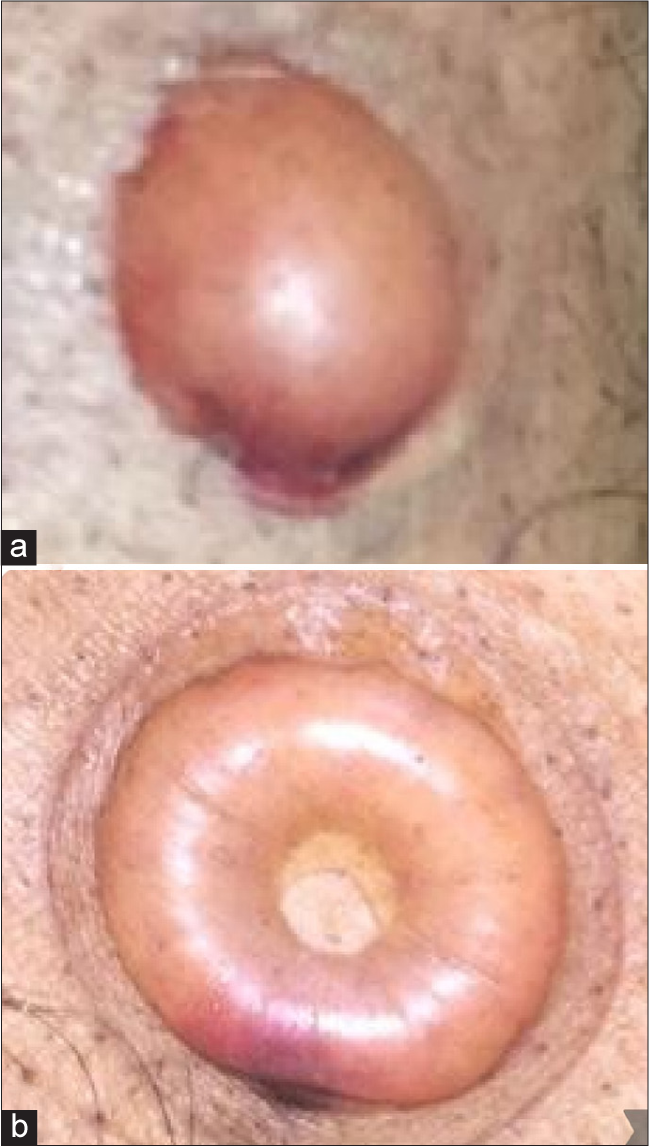
- (a) Traumatized suction blister produced by small suction syringe devices and (b) blister has umbilication in center due to pressure of the projected part of syringe piston.
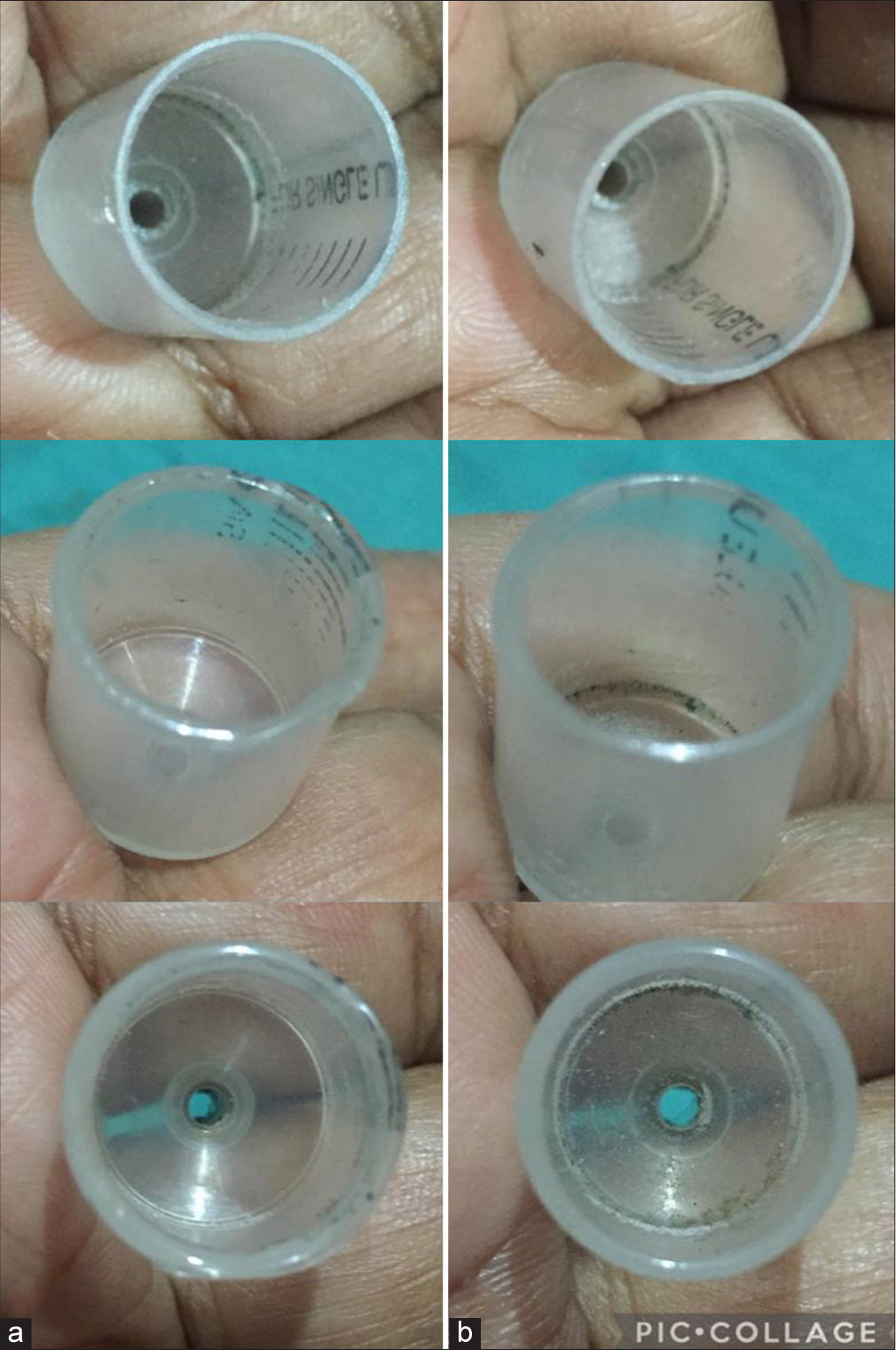
- The small suction cup devices with (a) uneven surface on heating after removing flakes in the inclined or horizontal plane and (b) with even surface on heating on the vertical plane.
SOLUTION
First, a disposable syringe (10 or 20 mL) is cut to the required length (1.5–2 times the syringe’s radius) using a surgical blade (22–26 No.) from the needle hub side. The cut end of the syringe is subsequently flattened by rubbing it against a pumice stone sterilized in glutaraldehyde (2%) or sandpaper (No.80 and 120). Following that, the flakes on the cup’s inner and outer edges are carefully removed with the surgical blade or rubbing with linen or gauze piece, and the device rim is heated in a vertical plane on a flame from a distance to make it smooth and evenly rolled, making it less traumatic and airtight to the skin. The device’s edges were then examined by placing a finger into the cup and rotating it over the finger. After vertical heating, the rim has a considerable smoother and thinner surface [Figure 3a-f]. Thus, after disinfection in glutaraldehyde, the modified syringe devices are ready to produce a suction blister. When employing a three-way cannula with a suction cup, air should be sucked out more than twice the capacity of the cup to achieve about -1 atmospheric pressure (−760 mm Hg) inside the device. However, the issue is not with the suction syringe. Before suctioning, the three-way cannula’s airproof must be tested. To ensure the gadget’s airproofing, connect the three-way cannula air tightly to the device and plug the other outlet snugly with gum or Fevikwik. Suction blisters can develop in 40–60 min, depending on the location, firmness, flatness, immobility of suction and the airtightness of the cannula [Figure 4]. It has been found that a smaller smooth-rimmed syringe or cup is better and faster for suction because it is easier for users and has more stability. However, for the suction process to work, the device must be airtight and atraumatic [Figure 5a and b]. Thus, the success of blister development is mostly determined by the suction device’s negative pressure magnitude, air tightness, stability, and rim softness, rather than the height of the suction column itself.
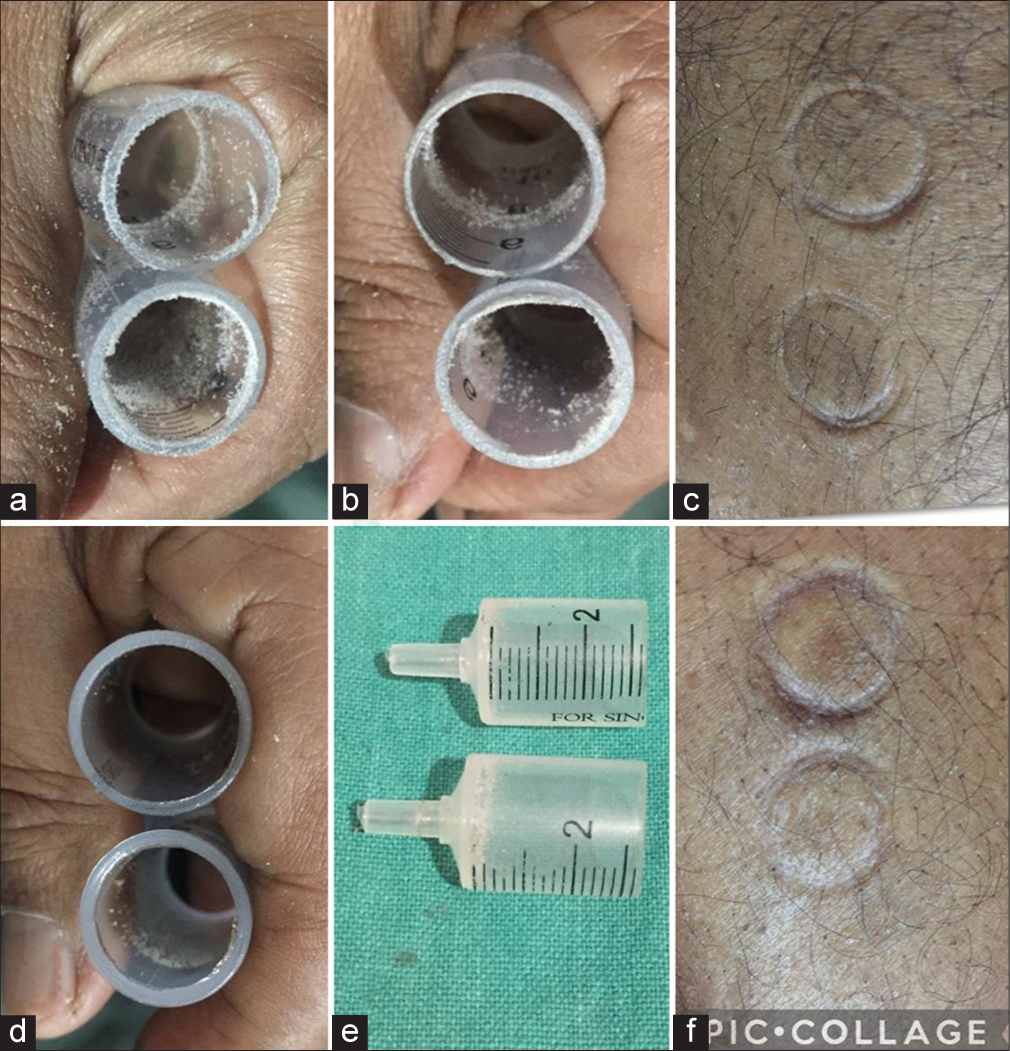
- Modified suction syringe cup devices and their impressions on the skin (a-c) after rubbing on sandpaper with and without flakes and (d-f) after heating them in the vertical plane and showing thinner, smooth rims of which flakes were removed before heating.
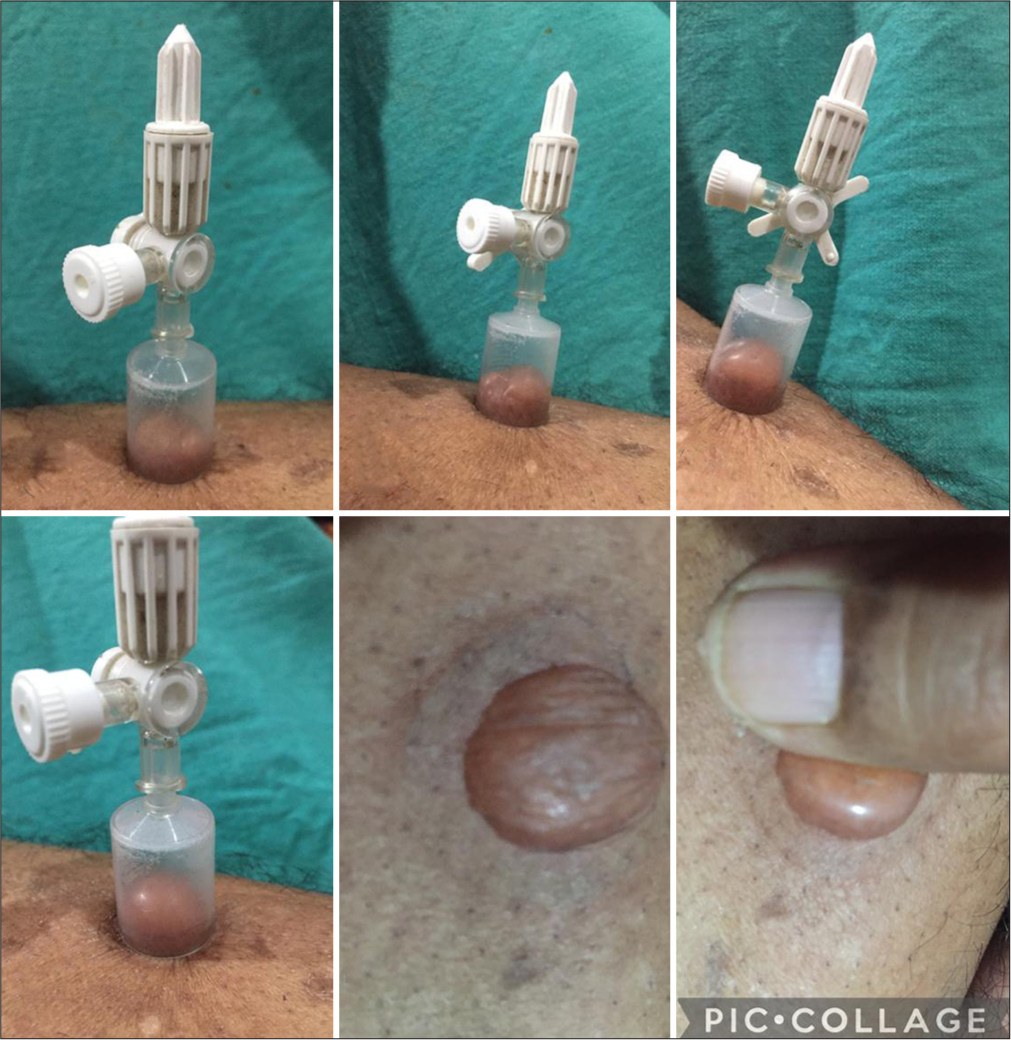
- The different stages of the suction process and a unilocular blister produced with a small suction cup and lateral pressure (or intrablister normal saline) can be applied to inflate the periphery to increase the graft size.
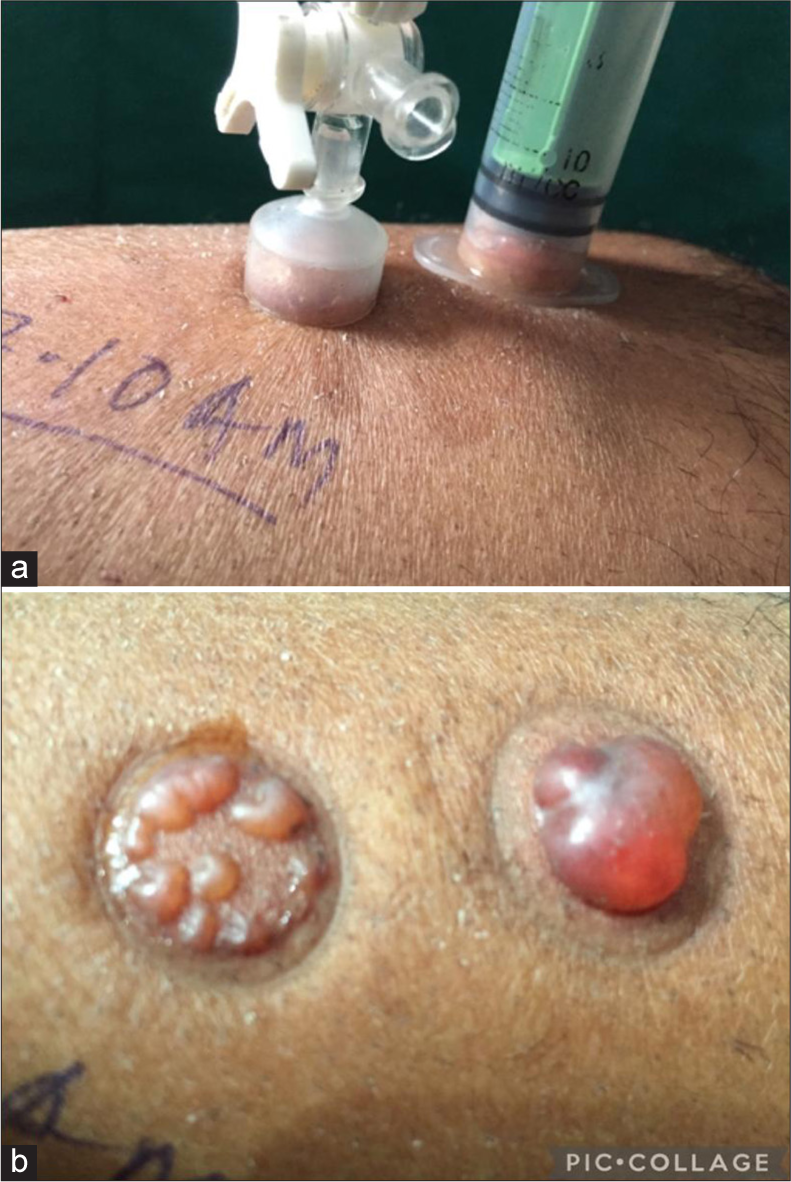
- (a) A small air-leaked traumatic suction cup with multiple small blisters and (b) A small airtight suction syringe with unilocular large blister.
Ethical approval
Institutional Review Board approval is not required.
Declaration of patient consent
Patient’s consent not required, as there are no patients in this study.
Conflict of interest
There are no conflict of interest.
Use of artificial intelligence (AI)-assisted technology for manuscript preparation
The author confirms that there was no use of artificial intelligence (AI)-assisted technology for assisting in the writing or editing of the manuscript and no images were manipulated using AI.
Financial support and sponsorship: Nil.
References
- Disposable syringe cup for 3-way cannula-syringe suction. J Am Acad Dermatol. 2022;86:e3-4.
- [CrossRef] [PubMed] [Google Scholar]
- Suction Pearl: Standardization of the suction heights of suction syringes. J Skin Stem Cell. 2021;8:e106099.
- [CrossRef] [Google Scholar]
- Suction pearl: Standardization of syringe suction cups sizes for the three-way cannula-cup device. Iran J Dermatol. 2022;25:380-2.
- [Google Scholar]
- Precision and efficiency unveiled: Optimizing suction blister formation through syringe edge refinement and height reduction. CosmoDerma. 2024;4:115.
- [CrossRef] [Google Scholar]





